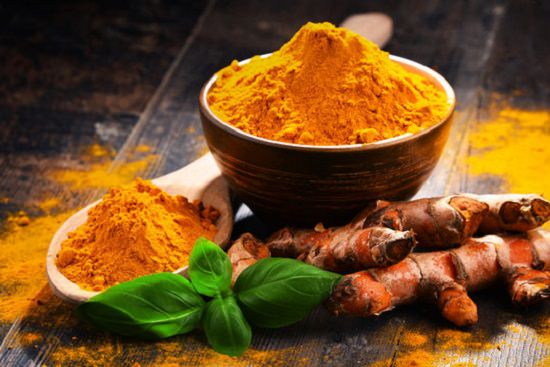Turmeric is a potent remedy for cough and flu related symptoms. Follow this easy turmeric flu remedy to ease the symptoms and boost the immune systems.

Curcuma longa, more popularly known as Turmeric, is a rhizome related to the ginger family. It is used as a spice, as a preservative, and as a colorant in food preparations in India, China, and Southeast Asia. In addition to its culinary uses, Turmeric has been found to have medicinal benefits too.
Traditionally, it has been used as a remedy for cold and cough, wounds and burns, liver diseases, sinusitis, and rheumatism, to name a few.
Indian systems of alternative medicine like Ayurveda, Unani, and Siddha have used Turmeric in their medicines for thousands of years. In recent years, scientific studies on Turmeric have proved that it does have multiple medicinal properties.
Properties:
- The bioactive element in Turmeric is the yellow color pigment called curcumin (Diferuloylmethane). It has multifarious effects on our body systems.
- Has below properties:
- anti-inflammatory
- antioxidant
- anti-carcinogenic
- anticoagulant
- anti-diabetic
- antifibrotic
- anti-fungal
- antibacterial
- hypercholesterolemia
- hypotensive
- antiviral
- anti-fertility
- antimutagenic
- anti-Alzheimer’s
- antiprotozoal
- anti-venom
- antidepressant
- anti-ulcer effects.
- Useful in treating urinary tract infections, skin infections, digestive disorders, conjunctivitis, smallpox, chickenpox, and liver ailments.
- It is also a proven detoxifier.
- In addition to these effects, it is safe to prescribe/consume turmeric in relatively high doses as your body tolerates it well.
Turmeric Flu Remedy

Flu is an illness of the respiratory system and mainly afflicts people during the winter season. It is characterized by symptoms like cough, sore throat, runny nose, mucus, sneezing, headache, fever, and body ache. Normally, if you have a healthy body and a good immune system, you will be resistant to the flu and other illnesses. But sometimes, due to the effect of free radicals in your body, your immune system becomes weak. Antioxidants fight damage caused by free radicals.
- Turmeric’s high antioxidant effects help boost your immunity. Its anti-inflammatory property helps relieve the symptoms of cold and flu.
- This eases breathing by reducing the swelling in your nasal passages and respiratory tract.
- Turmeric increases the production of mucus, which helps flush out microbes naturally from your respiratory tract.
- It’s antiviral and antibacterial properties fight infection.
- Studies have shown that Turmeric is an effective immunomodulatory agent, thereby enhancing your body’s antibody response to fight infections such as the flu virus.
- The high bacterial property of Turmeric makes it an effective combatant against cold and flu.
- Researchers at George Mason University have found that Turmeric is effective against certain viruses.
- Ginger, when used along with Turmeric, boosts its disease-fighting capacity.
- Black Pepper enhances the absorption of Turmeric into your bloodstream.
- You can follow the traditional method of making turmeric milk to deal with your cold and flu symptoms. Drinking turmeric milk helps both prevent and alleviate flu symptoms. It helps boost your immunity levels too.
How to use Turmeric to combat cold and flu?
- Combine one tablespoon of Turmeric with 3.5 ounces of raw honey and store it in an airtight container.
- Take ½ tsp doses every hour on the first day, the same dose every 2 hours on the second day, and three times on the third day. Alternatively, you can mix the dose in a glass of hot milk and drink it.
The fresh rhizome of ginger is more potent than its dry powdered form.
- Boil pieces of turmeric rhizome, ginger rhizome, and crushed black pepper in 2 cups of water.
- When the water reduces to half, strain it, add honey and drink the mixture hot to get relief from sore throat, cough, cold, and body ache.
- Another way to consume Turmeric is to boil milk and adding ½ a teaspoon of Turmeric and ¼ teaspoon of black pepper.
- Drink it hot at bedtime.
- You can also add dry ginger powder to the drink to make it more effective as ginger also has anti-inflammatory properties.
- Turmeric can also be consumed as a tea, which is an excellent remedy for cold and flu. Check out this recipe.
Turmeric Ginger Tea Recipe:

What You Need
- 8 ounces hot water
- Juice of a half a lemon
- 1 tbsp raw honey
- 2-inch piece grated ginger
- 1 tsp turmeric powder
- ½ tsp powdered cinnamon
What To Do
- In a saucepan, add the water, ginger, and Turmeric and bring it to a boil. Simmer while keeping it covered for 20 minutes.
- Take it off the flame and add lemon juice, honey, and cinnamon.
- Mix well and drink it hot.
Side effects of Turmeric:
- A safe dose of curcumin is up to 8gms daily for two months or up to 3 gms daily for three months.
- Consuming Turmeric every day in normal quantities in your cooking or making turmeric milk or tea usually produces no side effects.
- However, consuming abnormal amounts of Turmeric as a supplement can cause the below problems:
- heartburn
- Indigestion
- Gastrointestinal problems
- Nausea
- Risk of bleeding
- Increased risk of gallbladder stones
- Hypotension
- Increased risk of kidney stones.
- If you are on blood-thinning medication, then avoid consuming too much Turmeric.
- Turmeric is also said to lower testosterone levels in men resulting in reduced fertility.
- Applying Turmeric on the skin doesn’t cause any serious side effects.
